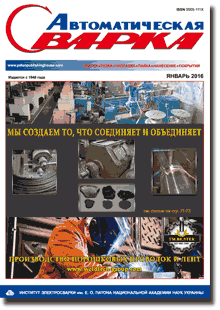| 2016 №01 (02) |
DOI of Article 10.15407/as2016.01.03 |
2016 №01 (04) |

Avtomaticheskaya Svarka (Automatic Welding), #1, 2016, pp. 19-32
Rheological investigations of non-isothermal pressure flows of coating mixtures for welding electrodes
A.E. Marchenko
E.O. Paton Electric Welding Institute, NASU 11 Kazimir Malevich Str., 03680, Kiev, Ukraine. E-mail: office@paton.kiev.ua
Abstract
Continuous flow capillary viscosimeter, presented in the form of abruptly narrowing stepped channel, and INSTRON 1251 testing machine were used to model the processes of pressure flow of coating mixtures for welding electrodes in extrusion chamber and in die space of production extruding machine. Thermocouple measurements were used to study the thermal conditions in pre-capillary zone, and visualization method was applied to analyze the structure of flow in it. Mathematical apparatus developed for calculation of rheological characteristics of polymer materials in the state of viscoelastic pressure flow was applied to calculate similar characteristics of the two types of coating mixtures for two types of low-hydrogen electrodes made with application of viscous in one and low-viscous liquid glass in another one. Grain composition of their filler is the same. Values of viscoelastic characteristics of the mixtures were calculated, including shear and longitudinal viscosity, elastic potential, first difference and coefficient of first difference of normal stresses and the relaxation period. Their dependencies on geometrical dimensions of stepped channels and values of volume flow of the mixture at capillary measurements were analyzed and commented upon, allowing for suspension nature of the mixtures, as well as resistance of pressure flows formed in them to viscoelastic instability. 12 Ref., 3 Tables, 12 Figures.
Keywords: rheology, welding electrodes, mixtures for coatings of low-hydrogen electrodes, viscoelastic characteristics of mixtures, pressure flow instabilities
Received: 30.11.15
Published: 15.03.16
References
- Sokolov, E.V. (1950) Electrodes with quality coating and their production. Delo, 11, 26–29.
- Marchenko, A.E. (2014) Thickness difference of electrode coating caused by elastic turbulence of electrode compounds under the conditions of nonisothermal pressure flow. The Paton Welding J., 6/7, 177–189. https://doi.org/10.15407/tpwj2014.06.38
- Marchenko, A.E. (2014) Effect of charge grain composition on rheological characteristics of coating mixtures for low-hydrogen electrodes. Ibid., 163–171.
- Marchenko, A.E. (2015) Examination of viscoelastic behavior of electrode coating mixtures in the state of pressure flow through cylindrical forming orifices. In: of St.-Petersburg Int. Sci.-Techn. Conf. on Welding Consumables (15–17 Oct. 2015), 79–89.
- Marchenko, A.E., Gnatenko, M.F. (1980) Specifics of flow of electrode coating mixtures, detected by capillary plastometer: Inform. Doc. of SMEA, Issue 1, 106–117.
- Marchenko, A.E. (2015) About thermal conditions, generated by viscous heating of electrode coating mixture in the zone of pressure flow formation. In: of St.-Petersburg Int. Sci.-Techn. Conf. on Welding Consumables (15–17 Oct. 2015), 65–78.
- Perlin, I.L. (1964) Theory of pressing of metals. Moscow: Metallurgiya.
- Yankov, V.I., Glot, I.O., Trufanova, N.M. et al. (2010) Flow of polymers in die holes. Theory, calculation, practice. Moscow, Izhevsk.
- Georgios, G. (2005) Stick-slip instability. In: Polymer melts instabilities, control and understanding. N.Y.: Dekker, 176–221.
- Philippoff, W., Gaskins, F.H. (1958) The capillary experiment in rheology. Soc. Rheol. II, 263–284. https://doi.org/10.1122/1.548832
- McKinley, G.H., Raiford, W.P., Brown, R.A. et al. (1991) Nonlinear dynamics of viscoelastic flow in axisymmetric abrupt contractions. Fluid Mech., 223, 411–456. https://doi.org/10.1017/S0022112091001489
- Vinogradov, G.V., Malkin, A.Ya. (1977) Rheology of polymers. Moscow: Khimiya.
The cost of subscription/purchase order journals or individual articles
| Journal/Currency | Annual Set | 1 issue printed |
1 issue |
one article |
| TPWJ/USD | 384 $ | 32 $ | 26 $ | 13 $ |
| TPWJ/EUR | 348 € | 29 € | 24 € | 12 € |
| TPWJ/UAH | 7200 UAH | 600 UAH | 600 UAH | 280 UAH |
| AS/UAH | 1800 UAH | 300 UAH | 300 UAH | 150 UAH |
| AS/USD | 192 $ | 32 $ | 26 $ | 13 $ |
| AS/EUR | 180 € | 30 € | 25 € | 12 € |
| SEM/UAH | 1200 UAH | 300 UAH | 300 UAH | 150 UAH |
| SEM/USD | 128 $ | 32 $ | 26 $ | 13 $ |
| SEM/EUR | 120 € | 30 € | 25 € | 12 € |
| TDNK/UAH | 1200 UAH | 300 UAH | 300 UAH | 150 UAH |
| TDNK/USD | 128 $ | 32 $ | 26 $ | 13 $ |
| TDNK/EUR | 120 € | 30 € | 25 € | 15 € |
AS = «Automatic Welding» - 6 issues per year;
TPWJ = «PATON WELDING JOURNAL» - 12 issues per year;
SEM = «Electrometallurgy Today» - 4 issues per year;
TDNK = «Technical Diagnostics and Non-Destructive Testing» - 4 issues per year.





